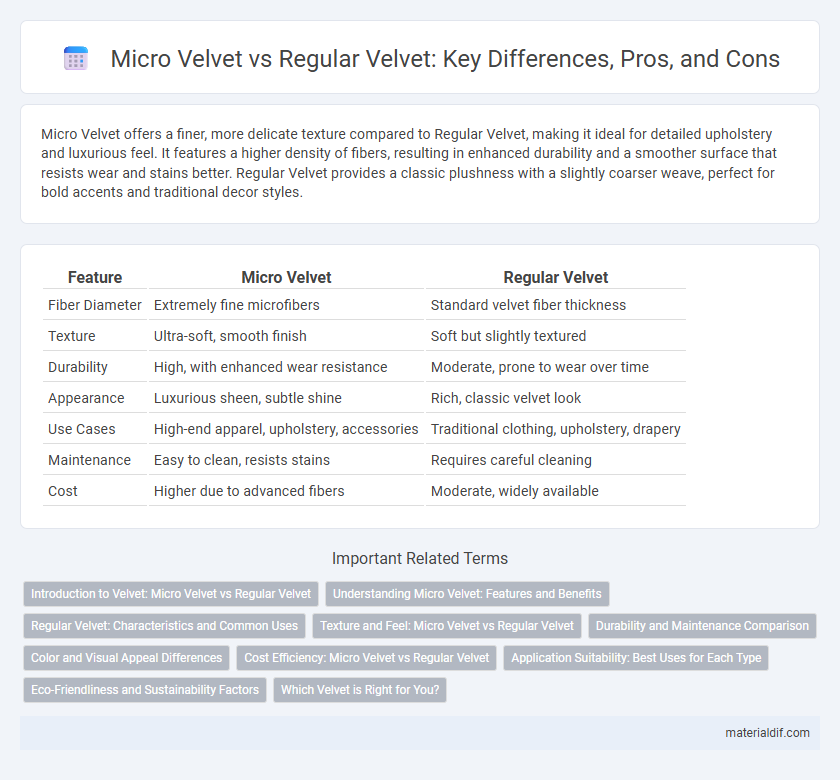Micro Velvet offers a finer, more delicate texture compared to Regular Velvet, making it ideal for detailed upholstery and luxurious feel. It features a higher density of fibers, resulting in enhanced durability and a smoother surface that resists wear and stains better. Regular Velvet provides a classic plushness with a slightly coarser weave, perfect for bold accents and traditional decor styles.
Table of Comparison
| Feature | Micro Velvet | Regular Velvet |
|---|---|---|
| Fiber Diameter | Extremely fine microfibers | Standard velvet fiber thickness |
| Texture | Ultra-soft, smooth finish | Soft but slightly textured |
| Durability | High, with enhanced wear resistance | Moderate, prone to wear over time |
| Appearance | Luxurious sheen, subtle shine | Rich, classic velvet look |
| Use Cases | High-end apparel, upholstery, accessories | Traditional clothing, upholstery, drapery |
| Maintenance | Easy to clean, resists stains | Requires careful cleaning |
| Cost | Higher due to advanced fibers | Moderate, widely available |
Introduction to Velvet: Micro Velvet vs Regular Velvet
Micro Velvet features ultra-fine fibers that create a smoother, more delicate texture with enhanced softness compared to Regular Velvet. Regular Velvet, woven with thicker yarns, offers a richer, more plush feel and greater durability suited for heavy-use furnishings. Both types share the luxurious sheen and depth of color characteristic of velvet, making them popular choices for upholstery and fashion.
Understanding Micro Velvet: Features and Benefits
Micro velvet features ultra-fine fibers that create a smoother, more durable fabric compared to regular velvet, offering enhanced softness and a luxurious feel. Its tighter weave provides improved resistance to wear and stains, making it ideal for high-traffic furniture and fashion applications. The breathable texture of micro velvet also ensures better comfort and easier maintenance without sacrificing the rich, elegant appearance characteristic of traditional velvet.
Regular Velvet: Characteristics and Common Uses
Regular velvet is a soft, dense fabric made from woven silk, cotton, or synthetic fibers, characterized by its rich texture and sheen. It commonly appears in upholstery, upholstery fabrics, curtains, and evening wear due to its luxurious feel and elegant appearance. The pile height and weaving technique contribute to its thickness and durability, making it suitable for heavy-duty applications and formal garments.
Texture and Feel: Micro Velvet vs Regular Velvet
Micro velvet features a finer fiber weave, resulting in a smoother, more supple texture compared to regular velvet's thicker, more pronounced pile. The dense construction of micro velvet offers a soft, luxurious feel ideal for garments and upholstery requiring gentle comfort. Regular velvet provides a richer, plush sensation with a slightly heavier weight, giving it a classic opulent touch favored in traditional decor and fashion.
Durability and Maintenance Comparison
Micro velvet offers enhanced durability compared to regular velvet due to its tightly woven synthetic fibers, making it more resistant to wear and tear. Regular velvet, often made from natural fibers like cotton or silk, requires gentler maintenance and is more prone to crushing and staining. Micro velvet's stain-resistant properties allow for easier cleaning with mild detergents, whereas regular velvet demands specialized care to maintain its texture and sheen.
Color and Visual Appeal Differences
Micro velvet features a finer fiber weave than regular velvet, resulting in a smoother surface and a richer, more saturated color appearance. The denser pile of micro velvet reflects light uniformly, enhancing color depth and creating a subtle sheen that highlights fabric texture. Regular velvet often displays a more varied color intensity due to its coarser texture, offering a plush look but with less consistent visual vibrancy.
Cost Efficiency: Micro Velvet vs Regular Velvet
Micro velvet offers greater cost efficiency compared to regular velvet due to its finer fiber composition, which requires less material for similar coverage and durability. Production processes for micro velvet typically involve lower energy consumption and reduced waste, further decreasing overall costs. Businesses benefit from these savings by achieving high-quality textile output while minimizing expenses in raw materials and manufacturing.
Application Suitability: Best Uses for Each Type
Micro velvet's fine fibers create a soft, lightweight fabric ideal for delicate apparel and upholstery requiring a smooth, luxurious feel, while regular velvet's thicker pile offers durability suited for heavy-use furniture and drapery. Micro velvet excels in applications demanding breathability and ease of maintenance, making it popular in fashion and decorative cushions. Regular velvet provides a rich texture and robust wear resistance, perfect for formal garments and high-traffic interior textiles.
Eco-Friendliness and Sustainability Factors
Micro velvet outperforms regular velvet in eco-friendliness due to its use of finer, often recycled fibers that reduce waste and lower environmental impact during production. Regular velvet typically relies on synthetic materials like polyester, which are less biodegradable and consume more energy in manufacturing. Brands adopting micro velvet emphasize sustainable sourcing, water conservation, and reduced chemical usage, enhancing overall sustainability without compromising luxurious texture.
Which Velvet is Right for You?
Micro velvet offers a finer, softer texture compared to regular velvet, making it ideal for delicate upholstery and clothing that demands a luxurious feel. Regular velvet provides a thicker, more durable pile, suited for high-traffic furniture and bold interior statement pieces. Choosing the right velvet depends on your preference for softness versus durability and the specific use in your home or wardrobe.
Micro Velvet vs Regular Velvet Infographic

 materialdif.com
materialdif.com